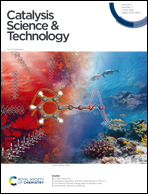Single-atom metal–N4 site molecular electrocatalysts for ambient nitrogen reduction†
Abstract
Electrochemical N2 reduction to NH3 is an emerging energy technology, attracting much attention due to its features of mild reaction conditions and being non-polluting. In this work, we demonstrate that a well-defined cobalt tetraphenylporphyrin (CoTPP) molecule as a model catalyst exhibits good electrocatalytic nitrogen reduction activity in 0.1 M HCl electrolyte with an ammonia yield of 15.18 ± 0.78 μg h−1 mg−1cat. calculated by the indophenol blue method and a Faraday efficiency (FE) of 11.43 ± 0.74%. The catalyst also has satisfactory electrolytic stability and recycling test reusability. The activity displayed by the porphyrin molecular catalysts is attributed to the full exposure of the metal–N4 sites. To trace the source of ammonia, an isotope labeling experiment (15N2 as the feed gas) is used to calculate the ammonia yield via1H nuclear magnetic resonance (NMR), which is close to that of the indophenol blue method. In addition, we replace the central metal to prepare CuTPP and MnTPP, and they also show electrocatalytic nitrogen reduction reaction (NRR) ability. This work proves the feasibility and versatility of using metalloporphyrin molecules as model electrocatalysts for NRR and offers a new strategy for the further development of molecular NRR catalysts.



 Please wait while we load your content...
Please wait while we load your content...